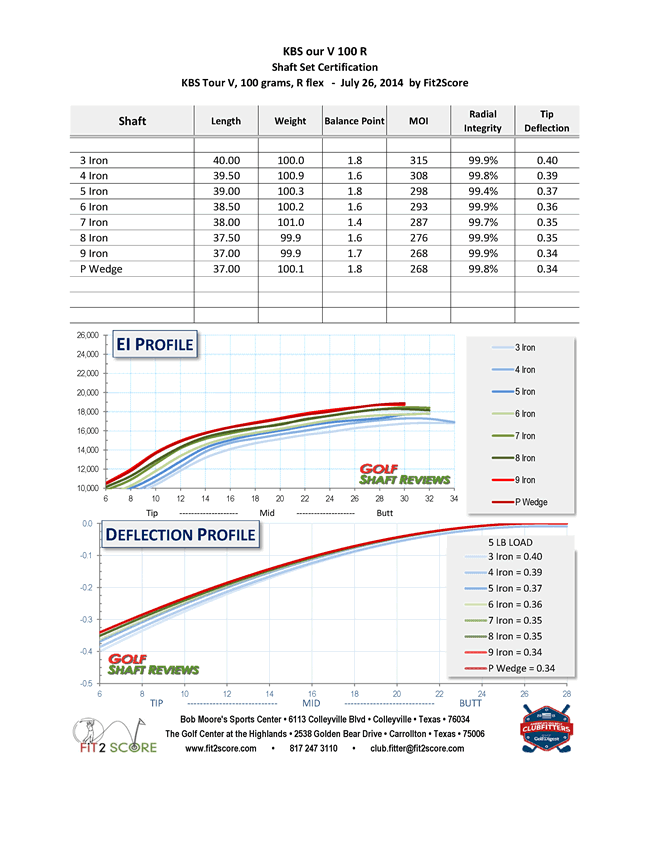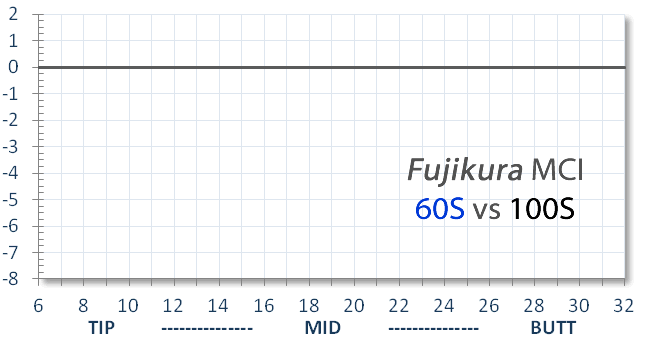EI Profile Iron Shaft Set Certification
Beyond Frequency Matching
By Russ Ryden, Fit2Score, A Dallas Fort Worth Club Fitter & Club Maker
The Golf Center at the Highlands, Carrollton Texas
I am asked if I offer frequency matching custom built irons sets. The short answer is no, frequency matching as practiced, is a legacy concept. Frequency matching is done by checking a single point near the butt of the shaft and declaring the set matched if this point falls along some linear progression. However, checking a single point does not assure that the rest of the shaft, especially the tip area is consistent. The Fit2Score EI technique, available from owners of our EI instrument, checks the shaft in 2″ increments, validating that the set of shafts used in your iron set are consistent from tip to butt. We go on to check torque, weight, balance and radial integrity.
Another legacy concept is shaft alignment. My position has long been that if a shaft requires alignment to make it playable, it should not be used. If it is essentially round to start with, alignment is a waste of time an money. But, roundness, the radial integrity of the shaft must be checked to assure that the shafts in your set consistent.
The following illustrations are from testing the upgrade of the Fit2Score iron set building and shaft certification software. I have been using a personal version of this system for several years. it is being refined for user friendly input. New reports are being created. The iron set shaft certification report covers many aspects of a shaft set including radial integrity, flex, weight, balance and torque. This has been my standard building practice on all sets for low single digit players for the last few years. Among high quality shaft sets about 1 in 15 sets has an outlier. It is usually a soft spot somewhere along the shaft. However in some cases, the outlier looks like it came from another planet.
This group of reports walks through the KBS Tour V shafts, starting with the 100g R flex and finishing with the two tour only versions, the 125 and 130 gram X flex. The last two pages show the KBS Tour X and the KBS CTaper X. It is a unique and interesting overview of the KBS family of iron shafts.
Each of these sets exhibit perfect uniformity in all aspects. The EI profiles consistently increase in stiffness from the wedge shafts to the long iron shafts. The shape of the profile curves do not change for any shaft in the set. You can expect consistent performance throughout iron sets built with these shaft sets.
If this is your first exposure to this measurement system you will note that it goes all the way to the tip. The first measurement is taken at 6″. The beam measured is from 1″ to 11″ from the tip. We are in fact, measuring the section of the shaft that is interactive during impact. You might hear that other devices using cantilever beams are more accurate. In fact, the EI formulas will lead you to believe this. However, we have learned through experience that 11kg is all the load we can put on a 10″ beam of light soft shafts without causing a failure. That load would have to be less in a cantilever system, thereby negating what appears to be an advantage by simply looking at the EI formulas.
Deflection has long been used as a way for club makers to understand shafts. The shaft is clamped at the butt or tip and a weight is hung from the other end. The amount of bend of the shaft has long been used as a measure of shaft stiffness. The certification pages shown above contain a deflection chart. That is derived by mathematically applying a load to the shaft. The bend of each section of the shaft is calculated with the load applied and the distance that section is from the load. Those individual section bends are then added to each other to create a composite view of the bend of the shaft. Shown below is an illustration of two shafts with different loads applied at the tip in much the way a shaft might be loaded during a golf swing. EI profiles can define dynamic behavior of the golf shaft.



